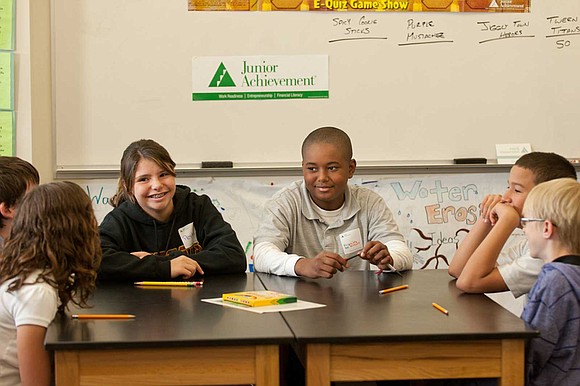Research Shows Teen Girls' Interest in STEM Careers Continues to Lag Boys' InterestResearch Shows Teen Girls' Interest in STEM Careers Continues to Lag Boys' Interest
Junior Achievement & EY survey of 13-17 year olds shows teens are changing plans based on the economy; surprising 91 percent know their future field of study
Style Magazine Newswire | 6/13/2017, 9:59 a.m.
Houston, TX - New research conducted on behalf of Junior Achievement and EY shows that a surprising 91 percent of teenage boys and girls ages 13-17 know what kind of job they want after they graduate from high school. That’s where the similarities between boys and girls end.
The data shows that career preferences remain drawn along gender lines, with more than one-third (36%) of boys pursuing careers in STEM vs. only 11 percent of girls. Twenty-six percent of girls plan to study for careers in the arts (vs. 10% of boys) and girls favor careers in the medical/dental field 24 percent to just six percent of boys.
Both boys and girls want to engage in meaningful work, yet meaning is in the eye of the beholder. For boys, fun and financial stability are essential. Girls, on the other hand, want to help people.
What appeals most to each (top three answers, ranked):
Boys on their dream jobs: Think it would be fun (28%), I’d be good at it (21%), I’d make a lot of money (17%)
Girls on their dream jobs: I would help people (25%), I’d be good at it (23%), I think it would be fun (20%)
“While it’s encouraging to see teens today are giving a great deal of thought to their career aspirations, it’s surprising to learn that there are still significant gaps between boys’ and girls’ interest in careers choice. We hoped to learn that girls, for example, would be more attracted to STEM careers beyond medicine – related to science, engineering, computers and math - since there is virtually unlimited opportunity for talented and qualified professionals in these fields,” said Rick Franke, president of Junior Achievement of Southeast Texas. “Our research shows that one-in-five JA alumni works in the same field as the JA volunteer mentor they had in school. Because role models are critically important, we are placing greater emphasis on getting STEM professionals to volunteer for JA classes.”
Students Know Money Matters
Personal or family economics and the status of jobs in America are changing 52 percent of students’ college plans. Teens’ altered plans include, for example, expecting to work and go to college at the same time or to attend a less expensive state school or community college. And, 85 percent of teens expect to pay for some or all of their education, whether through loans, scholarships or jobs.
Knowing this, it is surprising that while about three-fourths (73%) of teens’ high schools offer resources to help kids understand the costs of school and training, only one in three (33%) of students takes advantage of those programs.
From Passion to Preparedness
The workplace aspirations that influence boys’ and girls’ choice of career also differ:
Ability to have a meaningful career and a family (52% of girls vs. 46% of boys)
Ability to do something meaningful for the community/society (45% of girls vs. 33% of boys)
Flexibility in work schedule/location (39% of boys vs. 36% of girls)
Professional advancement to become a leader/expert (29% of boys vs. 23% of girls)
Virtually all teens picture a conventional route to their dream job: accepting paid/unpaid internships, volunteering for like-minded organizations or starting out in a related field. However, boys prioritize wanting to gain technology skills, while girls expect relationship building and teamwork to help them most in the workplace.
The skills teens want to learn to prepare for their dream jobs includes technology skills (54% boys vs. 27% girls), relationship building and collaboration (50% girls vs. 31% boys), speaking and giving presentations (39%), analytical/critical thinking (34%), business knowledge (26%) and writing (16%).
“The research findings around gender differences related to career skills and workplace aspirations further validate the importance of building a supportive and inclusive culture where diverse thinking and experiences are not only encouraged, but valued as we introduce the next generation of purpose-driven workers into the workforce,” said Gary Kozlowski, Partner, Ernst & Young LLP, who leads a network of EY leaders serving on more than 40 local JA boards across the US, Canada and the Caribbean. “It is a privilege to work with JA USA to mobilize EY professionals to serve as mentors in schools and classrooms. Our colleagues appreciate the opportunity to give back and support JA’s mission of fostering financial literacy, entrepreneurship and work readiness skills – a meaningful way for EY to demonstrate our commitment of building a better working world.”
Other Data Points
Only nine percent of boys and girls aspire to start their own business.
Only seven percent of boys and girls have chosen to work in public service.
The three top influences on career choices are parents and societal influences/TV/media, followed by a class or teacher.
In this survey, careers in STEM were further defined as scientist, researcher, computer programmer, engineer, physicist.
In this survey, careers in the medical/dental field were further defined as doctor, nurse, veterinarian, dentist, physical therapist.
In this survey, careers in the arts were further defined as musician, actor, artist, writer.
Methodology
This report presents the findings of ORC International’s Youth CARAVAN survey conducted among a sample of 1,000 13-17 year olds. This survey was live from February 28 to March 5, 2017.
Respondents for this survey are selected from among those who have volunteered to participate in online surveys and polls. Because the sample is based on those who initially self-selected for participation, no estimates of sampling error can be calculated. All sample surveys and polls may be subject to multiple sources of error, including, but not limited to sampling error, coverage error, error associated with nonresponse, error associated with question wording and response options.





